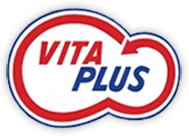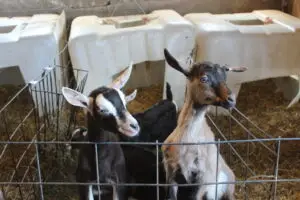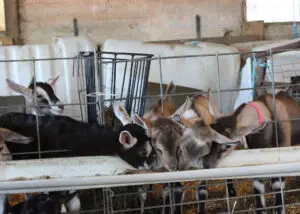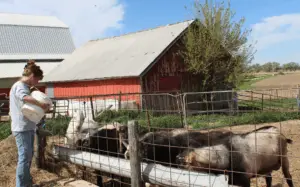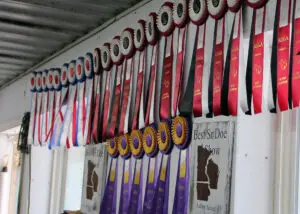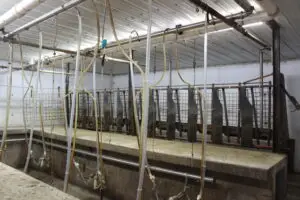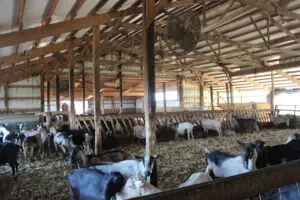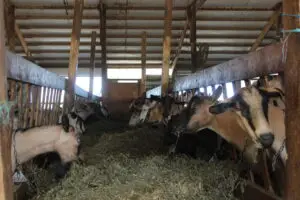
Virtual Farm Tour: Marran Dairy stands out in showring AND milking parlor
What began as two does that Randy and Mary Adamson purchased for a 4-H project in 1994 has now grown into a high-producing commercial milking doe and show herd.
Marran Dairy, located in Milton, Wisconsin, is owned and operated by Randy and Mary Adamson. They started milking dairy cows in 1979 but sold the herd in 1982. The couple had six children and dairy goats became a favorite 4-H project for the family. The show herd continued to grow and, in 2009, Randy and Mary decided to buy a local 160-doe commercial herd. They rented a barn for two years while updating facilities on their home farm. The herd moved into the updated facilities in 2011.
Today, Randy and Mary milk approximately 220 Alpine and LaMancha does. They also raise and house their own replacements and breeding bucks. With one-third of the herd registered for show, the farm’s genetic strategy is focused on increasing milk production as well as producing high-quality does that perform well in the showring.
Randy oversees the milking herd, and Mary manages the kids and youngstock. As a team, they prioritize raising healthy doe kids that turn into productive milking does.
Exceptional kid care
Mary has developed a protocol to set up kids for long-term success. Once a kid is born, it is moved into an individual warming pen. Within the first hour, the kid receives 8 to 12 ounces of Vita Plus SerPass 150 colostrum replacer. A second colostrum feeding of 12 to 16 ounces is given no more than 24 hours after birth. All kids stay in small group pens and are closely monitored for the first week of life.
At two days old, kids are introduced to Vita Plus VP Kid, a 24/25 milk replacer. At one week old, replacement doe kids are moved into pens in groups of five and remain in the same groups through weaning. Doe kids from the top half of the herd will receive an ear tag at birth and be raised on the farm while those born from the bottom half of the herd are sold to commercial producers. The majority of buck kids are sold to a local buck buyer, while some are kept to sell to other commercial farms for herd sires.
“In keeping the does out of the top half of the herd, we can rapidly grow while improving genetically,” Randy said.
Kids are fed 24 ounces of milk replacer twice a day and consistently offered warm water. They are introduced to an 18% kid starter pellet at two weeks old. Preventing disease is one of Mary’s top priorities, so she pays close attention to kids during feeding. As a result, in 2025, the farm only lost two kids.
“I always watch for bloat and respiratory disease,” Mary remarked.
To reduce stress, Mary utilizes a gradual weaning process to ease kids into the transition barn at two months old. Milk replacer volume is gradually decreased from 48 ounces to 24 ounces over the course of a week. They receive one milk feeding per day for another week and are then offered the starter pellet and water only. Once kids are fully weaned, they are moved into the transition barn.
Prioritizing productive does
The Adamson family has implemented effective breeding programs for the show and commercial herds. CIDRs are put into lower-producing does for synchronization of their estrus cycle. Approximately 30 does get CIDRs implanted in early August. A small percentage of the show herd is bred with frozen semen using artificial insemination (AI). Randy and Mary only use this method for a small number of the show herd due to lower conception rates. Mary is AI-certified and trains other dairy goat producers to artificially inseminate their herds. Most of the show herd and the commercial herd is hand-bred in a pen with a buck when they come into heat.
All does are offered baleage along with a free-choice mineral. With a semi load of baleage delivered to the farm each month, the Adamsons say it is a convenient and manageable feed source as each bale comes tested, weighed, and individually wrapped.
Does are milked twice a day in the parlor where they receive a custom parlor mix. The Adamsons conduct a Dairy Herd Improvement (DHI) test each month to track each doe’s milk production numbers. On a 305-day rolling average in 2024, the herd averaged 2,700 pounds of milk.
“Our current herd size works for us,” Randy remarked. “I am happy with our milk numbers and being able to turn a profit.”
The operation culls milking does when they are not meeting production goals. Randy said he culls approximately 30% of the milking herd each year.
Extended lactation program
One unique aspect of Randy’s herd management is the extended lactation program, which he’s utilized for eight years. A doe in extended lactation is milked for two to three years before being dried off. Currently, 70 of the herd’s does are in an extended lactation.
“I had one doe on extended lactation for seven years,” Randy said. “She averaged 10 pounds of milk per day for seven years.”
Because goats are seasonal animals, Randy has found this to be an easy program to maintain. The benefits include less kidding, decreased doe loss due to kidding issues, and more milk in the winter, which turns a higher profit.
The rest of the herd kids annually. Dry does are penned separately and fed a dry doe ration. When ready to freshen, they are penned near the parlor so they can be closely monitored.
The show herd
The show herd performs well in the showring, but the Adamsons said they are also proud of their productivity in the milking parlor.
Marran Dairy has had two does in the Spotlight Sale at the American Dairy Goat Association National Show and had the reserve national champion doe at the American Dairy Goat Association National Show in 2013. The family also enjoys attending the Wisconsin and Minnesota State Fair. They have won the Best Senior Doe in Show numerous times at the Wisconsin and Minnesota state fairs. They have won best dairy herd in show at the Minnesota State Fair several times.
“We will always be involved in showing dairy goats,” Randy remarked. “It is a true passion of ours and I love the connections we have made.”
Transitioning into the next chapter
Randy said he and Mary plan to continue operating Marran Dairy for a few more years before passing it to the next generation.
“I will continue to prioritize increasing our rolling herd average and keeping healthy does in production,” Randy said.
As Randy reflected on how far their operation has come from the first two does he bought in 1994 to the herd they have today, he said he is proud of all his family has accomplished both in the barn and in the showring. He is looking forward to what the next generation will do with Marran Dairy.
| Category: |
Dairy Goat Performance |
